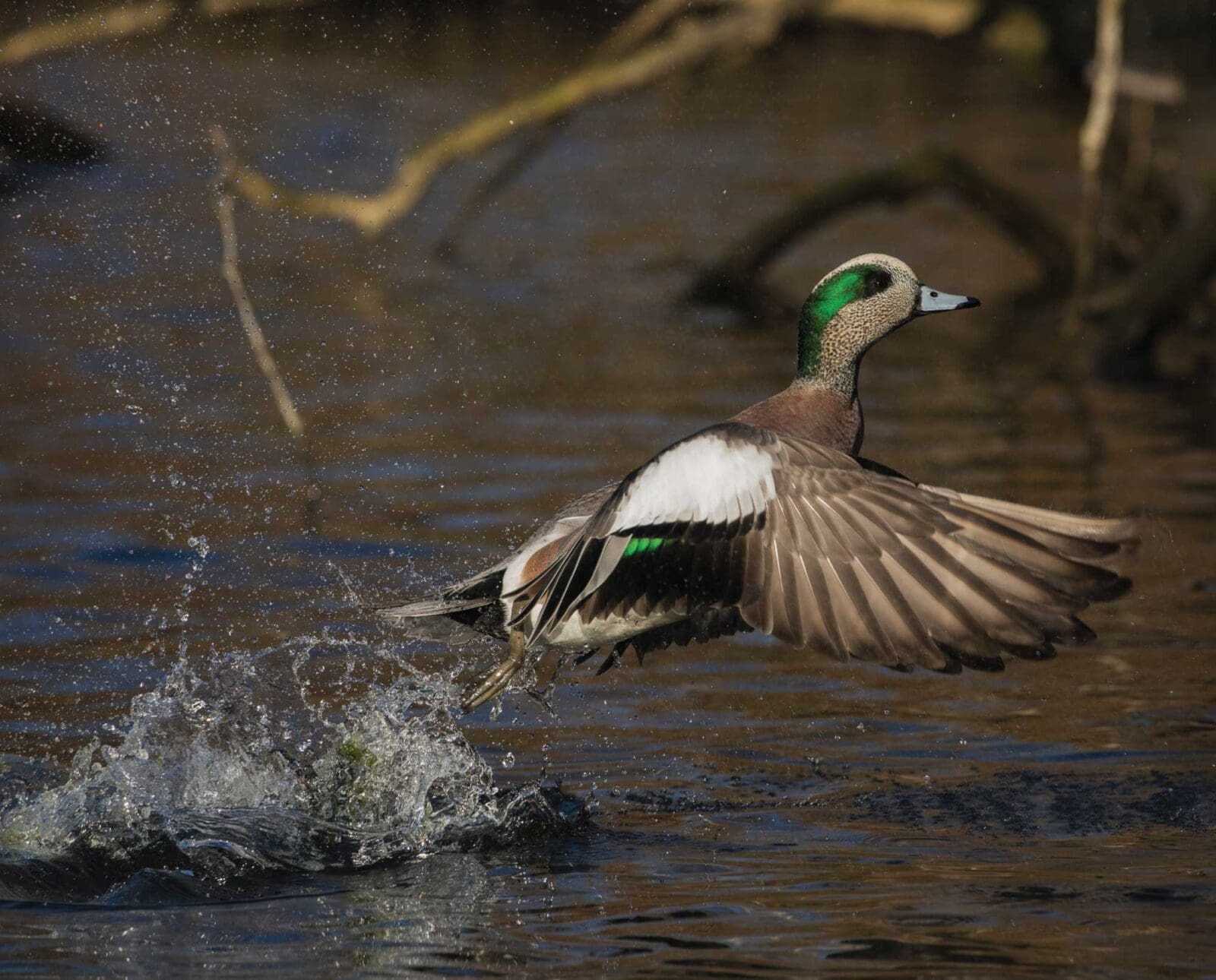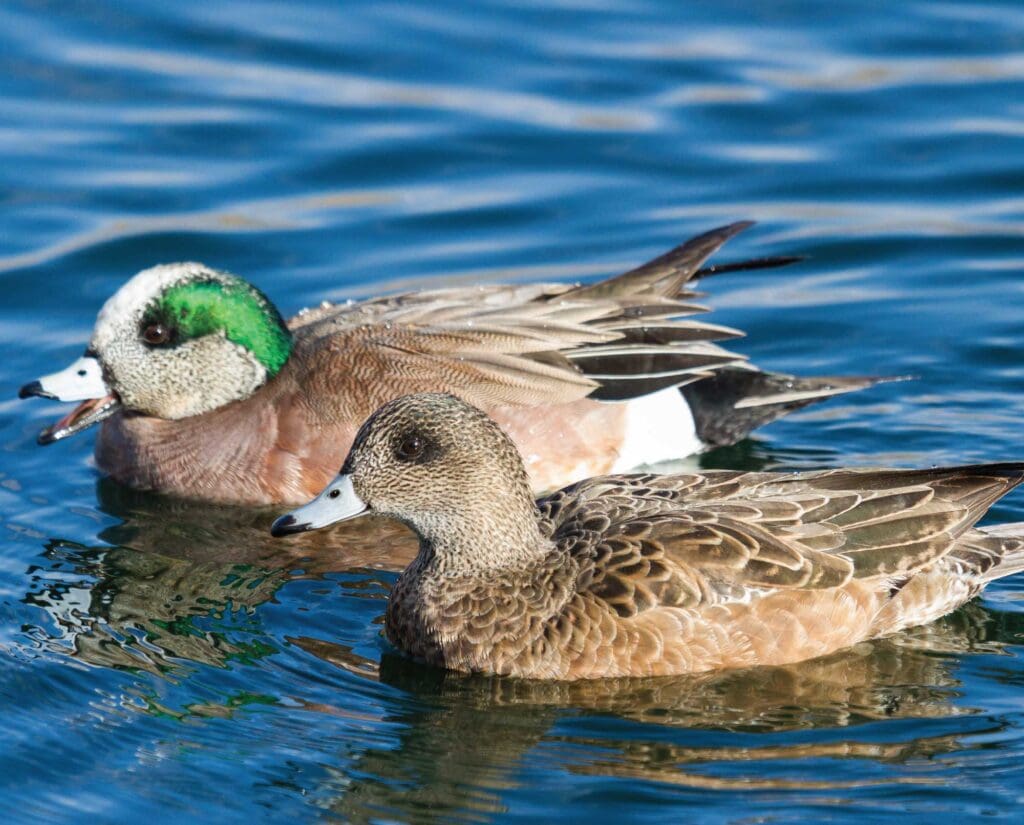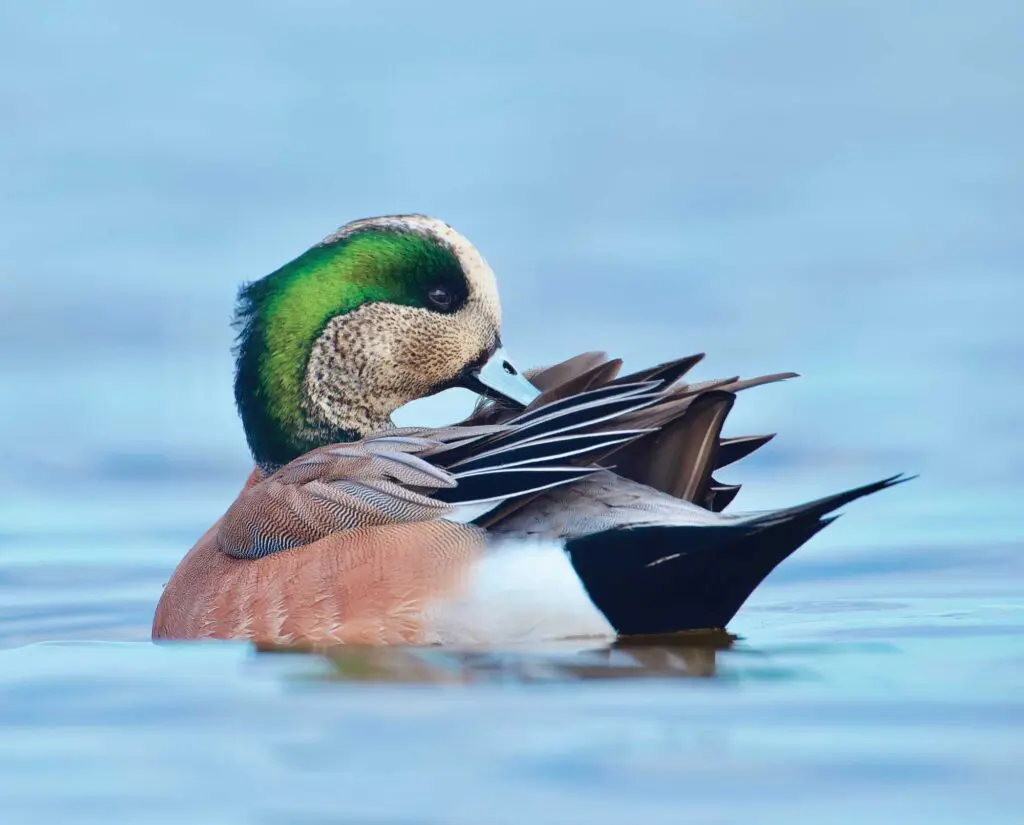Home » Waterfowl Hunting » American Wigeon – A Waterfowl Species Profile
American Wigeon – A Waterfowl Species Profile

Ryan Lisson is a biologist and regular content contributor to…
The American wigeon (Mareca Americana/Anas americana) is a subtly beautiful member of the dabbling duck family.
The American wigeon is equally at home foraging on land as it is rafting around in deep water with traditional diving duck species, but it can also occur anywhere in between the two. Here’s some more information you might find helpful on this interesting duck species.
Description and Life History of the American Wigeon
The American wigeon is smaller than a mallard, measuring roughly 16 to 23 inches long and weighing about 1 to almost 3 pounds (All About Birds 2019; NatureServe 2019). Breeding drakes have a dappled, brownish head with a bold creamy-white cap extending from their bill to the top of their head, and an iridescent green stripe behind the eye (All About Birds 2019). Their bodies and outer wings are light brown or cinnamon colored, their bellies are creamy white to yellowish, and they have a white rump with black tail feathers. In flight, their wings expose the green secondary feathers and white upper wing patch (All About Birds 2019). Hens and most non-breeding drakes have light brown/tan/reddish body feathers, with a dappled brown head and darker patch around their eyes (All About Birds 2019). Both sexes have short, light grayish-blue bills with black tips. Their legs and feet are generally gray.
American wigeon pairs form during the winter. Males display for females by showing their white wing patches and bobbing their heads. They generally arrive at northern breeding grounds in April or May and begin nesting later than many other dabbling ducks (NatureServe 2019; National Audubon Society 2019). Hens mostly choose nest sites on dry ground within one-half mile of water sources, hiding the nest among tall vegetation. They also line it with grass stems, reeds, cattails, weeds, and downy feathers (All About Birds 2019). The hen typically lays 6 to 12 cream/white eggs and incubates them alone for 22 to 28 days (All About Birds 2019; NatureServe 2019). The male usually leaves during the incubation period and molts his feathers. After hatching, the hen tends the ducklings alone until they are capable of flight and become independent at about 6 to 7 weeks.

The American wigeon feeds on both land and water and is very efficient either way. On deeper water, mostly while at their wintering grounds, they tend to associate with diving ducks and the American coot. They are very skilled at stealing plant materials foraged by these ducks as they aren’t very capable of diving themselves (NatureServe 2019; National Audubon Society 2019). During their brood rearing and molting phases, they feed on plant material and seeds (e.g., wigeon grass, wild celery, pond weeds, cattails, sedges, duckweed, watermilfoil, etc.) and agricultural crops (e.g., rice, wheat, barley, etc.) (National Audubon Society 2019; NatureServe 2019; All About Birds 2019). They will duck their heads underwater for some of these plants, but they will also happily graze on land. They will also eat insects and aquatic animals, including midges, flies, crickets, beetles, snails, and crustaceans.
When it comes to predators, the usual cast of characters are present. Foxes, raccoons, skunks, hawks, and crows steal eggs, catch ducklings, or nab an occasional adult bird whenever they can. But the American wigeon hen is savvy – if she locates an approaching predator, she will silently fly off and perform a distraction display to lure the predator away from her eggs or brood.
Range and Habitat of the American Wigeon
The American wigeon has a large winter range, extending along most of the Pacific Coast (from Alaska to southern Mexico), throughout the Gulf Coast states, and up the Atlantic Coast to New England (National Audubon Society 2019). During the summer breeding season, it migrates through much of the Eastern and Midwest states to arrive in the Plains states and throughout most of Canada. They will stay in these areas to breed, raise broods, and molt their feathers until it is time to return to their wintering grounds in the fall.
As mentioned above, the American wigeon is at home on land, in shallow water, or floating in deeper water. During the winter, they will raft up on deep lakes or coastal estuaries with other duck species. However, they spend most of the summer breeding season in shallow marshes, wetlands, lakes, bays, and flooded fields (National Audubon Society 2019; NatureServe 2019). Much like the northern pintail or blue-winged teal, hens typically nest on dry ground within fields and grasslands adjacent to water sources.

Conservation Issues for the American Wigeon
The American wigeon is listed as globally secure and of Least Concern by the IUCN Red List (NatureServe 2019). The global breeding population is estimated at about 1.4 million birds, but their population has decreased by about 2 percent each year between 1966 and 2015 (All About Birds 2019). The conversion and loss of wetlands and grasslands due to agriculture and other development has decreased the amount of total habitat available for this species, like many others. Additionally, droughts during the summer breeding season can also shrink the remaining habitat and food supplies, which definitely affects waterfowl production in a given year. Hunters were permitted to shoot 647,835 American wigeon annually from 2012 to 2016, but these numbers are watched carefully to avoid over-harvest (All About Birds 2019).
Hunting Opportunities for the American Wigeon
Although the American wigeon tends to spend its summers throughout Canada and the Plains states, you will probably still have a chance to hunt them as they migrate through your state in the fall. That being said, they are common migrants within the Pacific and Central flyways.
Equipment and Bag Limits
Duck hunting gear can get as complicated as you want it to, but you don’t need all that much specifically for wigeon hunting. If you already duck hunt, it’s likely you have everything you need. Essentially, you will need a reliable shotgun (12-gauge is generally the sweet spot for most ducks), wetland or grassland-appropriate camouflage clothing, a blind of some sort, and some decoys. As with other duck hunts, the American wigeon is a migratory waterfowl species, so you will need a federal duck stamp to hunt them in addition to your hunting license. As always, you will also need to use non-toxic shot. The current daily bag limit for the American wigeon is six birds.
American Wigeon Hunting Techniques
If you live in an area without a lot of wigeon, it will probably help to do some scouting and find locations that might attract or support migrating flocks beforehand. Flooded fields and pastures adjacent to water-bodies can be very attractive to this duck species, and are definitely worth checking. In these areas, you can get by using strictly American wigeon decoys or as part of a mixed dabbling duck decoy spread. But adding a few diving duck decoys or American coot decoys (if you have them) may help entice a small flock to land – remember, they like to steal food from these species over the winter. Keep this trick in mind if you’re noticing wigeon but they just aren’t committing to your spread.
As for calling, you can use a wigeon whistle to get the attention of flocks passing by. They may respond to your other mixed duck calls as well, but the whistle seems to really call them in. It’s fairly likely that wigeon will come in as part of a total mixed bag hunt, so make sure you study the proper identification beforehand. If you’re fortunate enough, you may end up getting a few wigeon within range to liven up your next hunt.
Ryan Lisson is a biologist and regular content contributor to several outdoor manufacturers, hunting shows, publications, and blogs. He is an avid small game, turkey, and whitetail hunter from northern Minnesota and loves managing habitat almost as much as hunting. Ryan is also passionate about helping other adults experience the outdoors for their first time, which spurred him to launch Zero to Hunt, a website devoted to mentoring new hunters.




